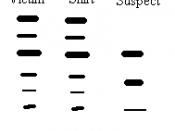DNA, AND ITS ISSUES WITH THE LAW
DNA is often related to the individual cell as the director of an epic motion picture, the coach behind the bench of a 6-time Stanley Cup championship team, and or a normal high school law teacher trying to make a difference in the lives of his or her students every single day of the year. Basically, DNA is what makes up the vital foundation of every living component that is essential to the existence of life. The "Junior Encyclopedia of Canada," defines DNA as deoxyribonucleic acid. Apart from identical twins, no two people have precisely the same DNA. Thus, it appears ideal to utilize DNA evidence to assist in the search for criminals. However, does the use of DNA evidence infringe on the rights of the innocent? Indeed, DNA evidence does violate the rights of the innocent, by infringing the right to be secure against unreasonable search and seizure, the right to privacy, and the right of privilege against self-incrimination.
Throughout history, the application of DNA in crime fighting has been littered with situations in which the goals of the crime fighter have come into conflict with the goals of the society. In accordance to the book "Laboratory aids for the Investigator," DNA made its initial impact in the 1890s, and was the first time that DNA was originally applied to crime fighting by Sir Francis Galton of Scotland yard. The new technique of crime fighting was a break through in the science field and offered many benefits to detectives and to society in a whole. However, it posed many discrepancies in the midst of the people of justice and caused an uproar amongst the public. It also addressed several inconsistencies within the law itself. That is why the "Canadian Charter Of...


